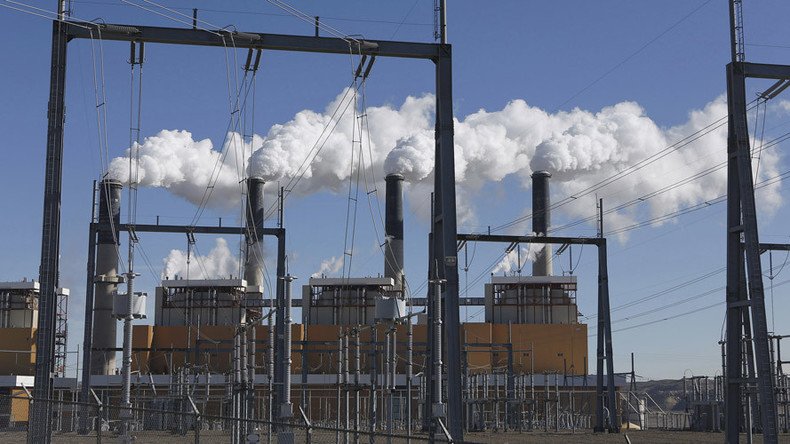Mercury from Asia rains in Rocky Mountains – study

Rainfall samples show increased levels of mercury are showing up in the Rocky Mountains to the Midwest but continuing to drop along the East Coast, according to a new study. The culprit is consistent with emissions from coal-burning power plants in Asia.
Scientists from University of California Santa Cruz and University of Illinois at Urbana–Champaign analyzed data from a network of monitoring sites in the US and Canada that collected rainwater samples to test them for mercury, sulfate, nitrate and others pollutants going back to 1997. When researchers looked at 71 sites in the Midwest, Rocky Mountain and West Coast regions over the period of 2007 and 2013, they found many sites showed increased mercury concentrations, as much as 2 percent rise per year.
“It’s a surprising result,” David Gay from the University of Illinois at Urbana–Champaign, who is a co-author on the new study, told Scientific American. “Everybody expected [mercury levels] to continue going down. But our analysis shows that may not necessarily be the case.”
#airpollution Mercury splatters the central U.S.: Rainfall in the Rocky Mountains shows a surprisin... https://t.co/JViHXE7rvT#pollution
— Environmental News (@Article_Home) February 19, 2016
As it is a recent increase, scientists cannot be sure what the implications are for the environment or public health. Mercury levels in rainfall along the East Coast have been trending steadily downward over the past 20 years. They believe the increased levels in the Central US are consistent with the effects of rising mercury emissions from regions outside the US and Canada, and the influence of long-distance transport in the upper atmosphere.
"A lot less mercury is being emitted to the atmosphere in the US and Canada than 20 years ago as a result of regulations, efforts by industry, and the economic realities of cheap natural gas," said Peter Weiss-Penzias, an environmental toxicologist at the UC Santa Cruz, who is the lead author of the study, in a statement.
The Mercury Pollution Strikes The Grand Canyon [VIDEO] https://t.co/sfBhboP4xN@Thom_Hartmann
— RT America (@RT_America) September 1, 2015
Weiss-Penzias said the findings are consistent with emissions of mercury from coal-burning plants in Asia, which have been increasing. The emissions are transported over long distances in the upper atmosphere by wind currents. As the wind travels towards the high elevations of the Sierra Nevada and Rocky Mountains, they are trapped around the mountain face which causes mercury from the upper atmosphere to be deposited in rainfall. Rainfall is then carried over the western states such as Nevada, and Idaho.
Supreme Court strikes down EPA rules on mercury emissions from power plants http://t.co/2pyP924ierpic.twitter.com/ucALGFzaqi
— RT America (@RT_America) June 29, 2015
Mercury is a toxic element. A third of mercury on Earth is naturally occurring but two-thirds is released through human activity such as the burning of coal. Rainfall washes the mercury out of the atmosphere and into soils and surface waters.
“As a general rule, we are very concerned about mercury because it can be present at very dilute levels in the environment, parts per trillion, but in the food chain – in a food that we eat and that other animals eat – it can reach levels that are toxic,” said Weiss-Penzias.
Bacteria convert elemental mercury into a more toxic form, methylmercury, which becomes increasingly concentrated in organisms higher up the food chain. Mercury concentrations in some predatory fish are high enough to raise health concerns because of its effect on the central nervous system, bone marrow and kidneys.
“It is possible that the calculated rise of 2 percent per year will result in a large accumulation in the ecosystem over the coming years,” Weiss-Penzias told Scientific American. “And once an ecosystem is contaminated with mercury, it can take decades for it to become uncontaminated.”
The study, Trends in mercury wet deposition and mercury air concentrations across the U.S. and Canada was published last month in Science of the Total Environment.
This is not the first account of poison migration. Last December, a group monitoring for signs of radiation levels at sites off the West Coast in the wake of the damaged Japanese nuclear power plant in Fukushima, found increasing levels of isotopes of cesium in seawater samples. One sample collected west of San Francisco displayed the highest level to date.
Fukushima Can Now Kill You Within 45 minutes. https://t.co/I0fYw1S2Xm@RT-America #TheBigPicturehttps://t.co/EV35x6kWmo
— S.Vision Family (@SinSir1st) November 4, 2015
The Fukushima Daiichi nuclear power plant was crippled during the March 2011 quake and tsunami, releasing high amounts of radiation-poisoned water into the environment.
The highest level was detected in a sample collected about 1,600 miles west of San Francisco and was 50 times higher than other samples collected along the West Coast so far, but it is still more than 500 times below the US government safety limits for drinking water.












